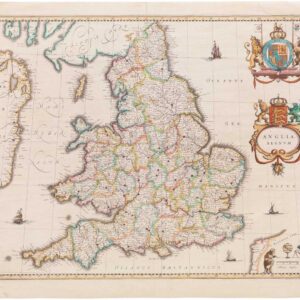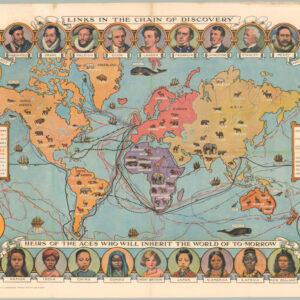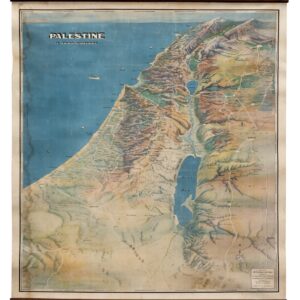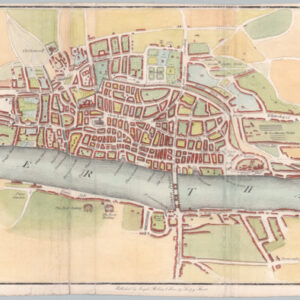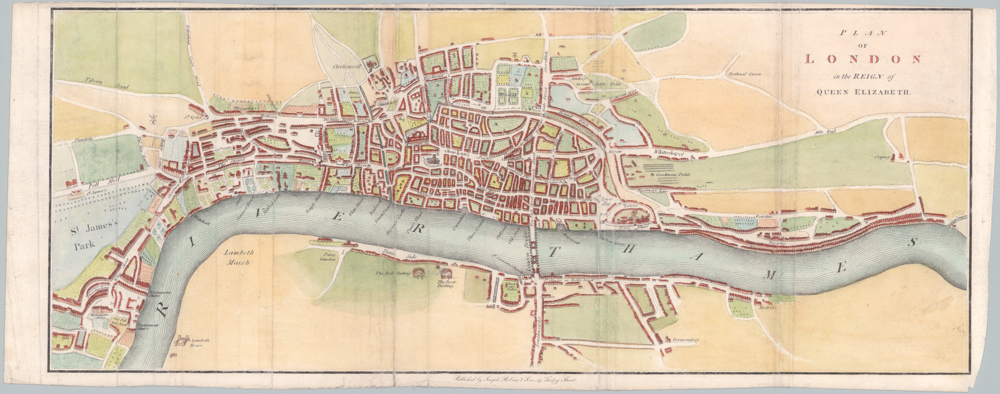A rediscovered painting by MacDonald Gill, one of the foremost artists of pictorial cartography.
[Pictorial Map of West Sussex, England].
$45,000
1 in stock
Description
This remarkable hand-painted panel map is a rediscovered masterpiece by MacDonald “Max” Gill (1884–1947), Britain’s preeminent designer of pictorial and architectural maps. Commissioned in 1930 by Edward Hunter, the influential head of Sun Engraving, the work reflects Gill’s signature blend of wit, craftsmanship, and personalized detail. Only two examples were made; the whereabouts of the second remain uncertain, while this one — presumed lost for nearly 60 years — has now resurfaced in private hands.
Executed with oil paint on a single carved wooden panel, the map captures West Sussex and surrounding counties in Gill’s playful cartographic language. Coverage extends along the coast of the English Channel between Chichester Harbour (near Portsmouth) and Shoreham, and inland as far as Aldershot and Guildford, some 30 miles south of central London. Gill was well-familiar with this area, having lived in and around Chichester (towards bottom-left here) for much of his life. Miniature vignettes of manor houses, ships, churches, and farms accompany towns, roads, forests, railways, and landmarks. The piece is richly embellished with a decorative compass rose, whose center subtly incorporates the initials “EH” (Edward Hunter), and opposing sun and moon motifs.
This panel is more than geographic: it is narrative. Hidden among the place names are personal inscriptions referencing Hunter’s family, home, and legacy. The estate of Mickleham is marked with the initials of Hunter’s parents and siblings, while two schools — Prior’s Field and Bedales — attended by his children are carefully noted. His newly built home, “Easeway” in Frensham (completed in 1930), is shown with architectural precision and differently colored text, further underlining the map’s commemorative function.
Provenance and Parallel Map
Edward Hunter commissioned two nearly identical panels from Gill in 1930, paying a total of £75, as recorded in Gill’s ledger. One hung in his Frensham residence; the other was installed in the home of Prime Minister David Lloyd George in nearby Churt. The George example appeared in a 1938 Country Life article — its presence confirmed by the initials “L.G.” and depiction of his Churt estate on the Hunter version. Following Hunter’s death in 1965, this map disappeared from public view until its recent rediscovery.
Significance and Institutional Value
This map is a masterwork by the most influential British map designer of the English Arts and Crafts movement. It is a historic piece of English cartographic art, with documented provenance from the estate of a notable English patron. Original Gill works such as this are extremely scarce and only very occasionally come to market; the last wood panel oil painting map done by Gill came to auction in 2019 and fetched 50,000 GBP. Most of Gill’s extant originals are held by his descendants or installed as murals and paintings in churches, halls, and museums.
Gill’s similar cartographic oil paintings on wood include the 1924 ‘Map of the City of Westminster’ held at the City of Westminster Archives Centre, the 1930 ‘Map of the Pytchley Hunt’ held at Kelmarsh Hall, his undated ‘A Map of the Cities of London and Westminster’ and ‘A Plan of the Houses of Parliament’ held in the Parliamentary Art Collection, the 1931 ‘A Map of England, Wales and Northern Europe showing all the branches of WH Smith’ in private hands (the work auctioned in 2019), a 1933 ‘Map of Worthing’ displayed in the Mayor’s office in Worthing Town Hall, and the undated ‘Wind Indicator Map of Holy Island and the Northumberland Coast’ installed at the National Trust, Lindisfarne Castle.
This is an extraordinary opportunity to attain a work by one of Britain’s greatest cartographic artists of the 20th century.
Cartographer(s):
Leslie MacDonald Gill (October 6, 1884 – January 14, 1947), professionally known as MacDonald Gill and to friends as ‘Max’ Gill, was an English artist, graphic designer, architect, and cartographer. Born in Brighton, Gill’s father was a Congregationalist minister who was ordained in the Church of England in 1897, upon which he and the family moved to Chichester, before moving again two years later. As a teenager (1901 – 1903), Max was ‘articled’ (interned) with an architect in Bognor Regis, then spent five years in London working as an assistant for ecclesiastical architects Nicholson & Corlette.
In 1911, he established an independent architecture firm in London, but in fact many of his commissions in the following years were for artistic works, including pictorial maps. Both Max and his brother Eric (1882 – 1940) became noted artists of the era, with Eric being a leader in the Arts and Crafts Movement who has been dubbed ‘the greatest artist-craftsman of the twentieth century’ (Oxford Dictionary of National Biography). As for Max Gill, although he worked in a variety of media, he became best known for his rich and stunning pictorial maps, including a 1914 map for the London Underground called the ‘Wonderground Map’ (brother Eric had designed the font used in Tube stations signs, while Max similarly designed lettering for the Imperial War Graves Commission after World War I).
Max Gill married Muriel Bennett in 1915 and in 1919 they moved to Chichester. In 1926, they moved to West Wittering, in a house Max designed. Gill kept up an impressive output of paintings, maps, publication cover images, furniture, graphic design, and other works, including propaganda works during the Second World War. In recent years, his work has been the subject of special exhibitions and retrospectives on both sides of the Atlantic.
Condition Description
Paint on wood, covered with varnish. Image area and frame are all of a single piece of wood, recessed along the 'frame' edge. Areas of surface abrasion where paint and/or varnish have been scraped off. Wear along outside edge/ 'frame'.
References
*Special thanks to MacDonald Gill expert Caroline Walker for her help in researching this map.
